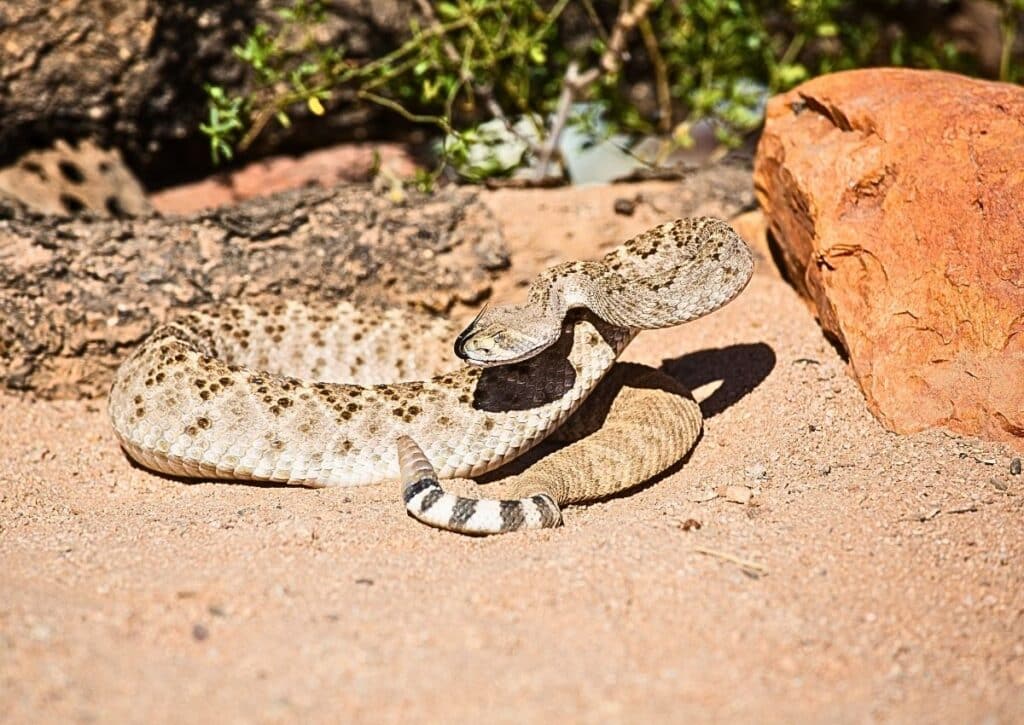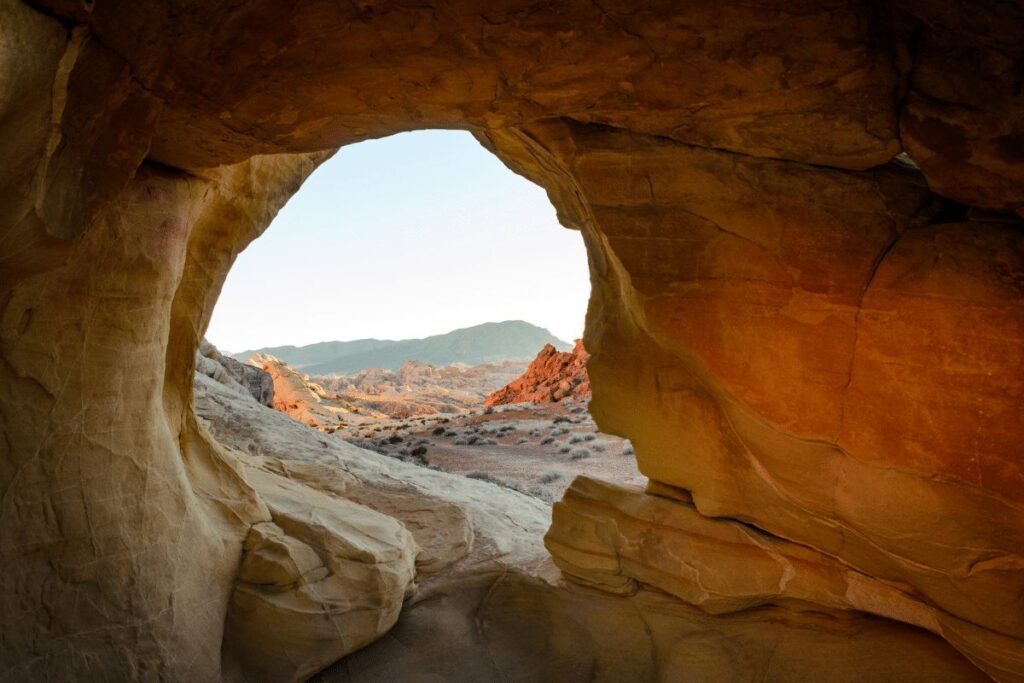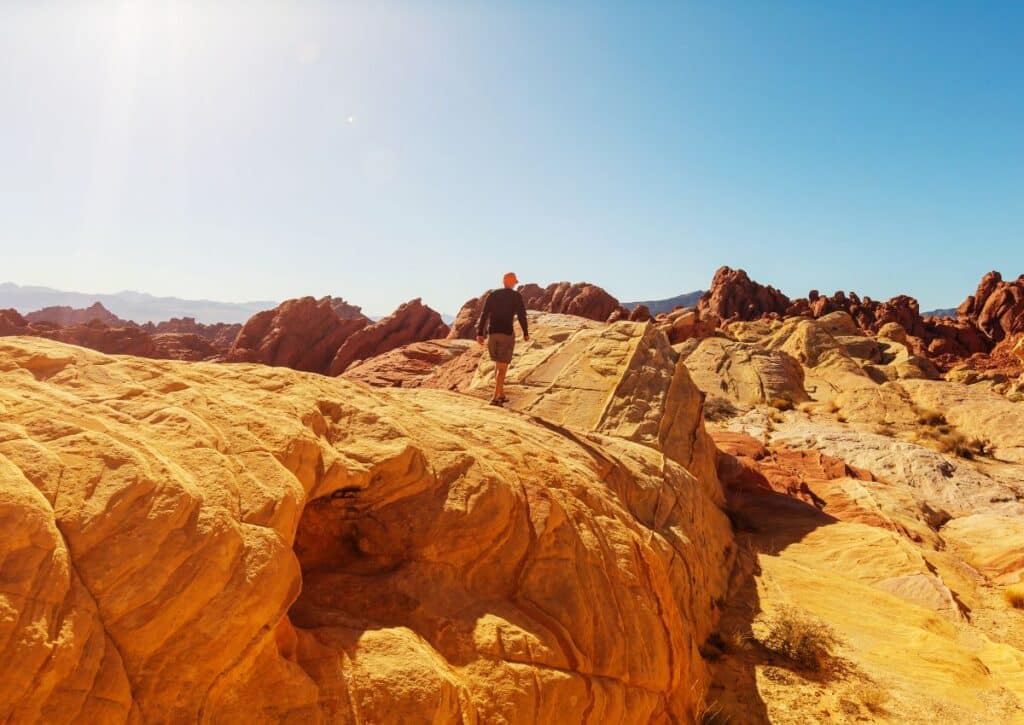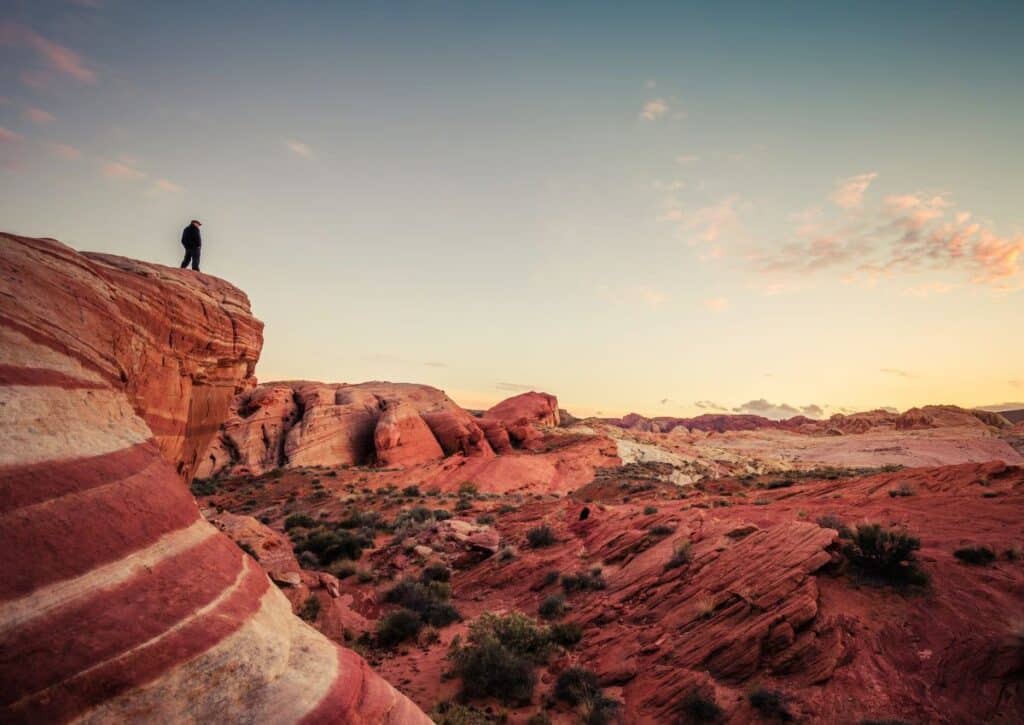Expert guide to Dangerous Animals in Valley of Fire: Discover, respect, and safely navigate encounters with the park's most formidable residents.
The Valley of Fire, with its captivating red rock formations and sweeping sand dunes, is not just a haven for adventurers and photographers—it’s also home to a diverse array of wildlife.
As a curious wildlife enthusiast, you’ll be intrigued to know that this stunning desert landscape serves as a habitat for a range of animals, some of which possess defensive mechanisms that can be harmful to humans if not approached with caution.
This guide isn’t meant to alarm, but rather to enlighten. By being informed about the creatures you might encounter, you can appreciate their unique roles in this desert ecosystem while ensuring a safe and memorable experience.
From the elusive Gila Monster to the stealthy Mountain Lion, let’s embark on a journey to discover the incredible, and occasionally dangerous, animals of the Valley of Fire.
Dangerous Animals of the Valley of Fire – A Call for Respect, Not Fear
Nestled amidst the grandeur of southern Nevada lies the Valley of Fire, a mesmerizing expanse of undulating red rock formations, petrified dunes, and a rich tapestry of desert flora. This ancient landscape, shaped over millennia, isn’t just a testament to nature’s artistic prowess but is also home to an assortment of intriguing wildlife.
Rather than labeling them as “dangerous,” it’s more apt to understand that these animals demand our respect. They’ve adapted and evolved unique mechanisms to survive in such a challenging environment, and these very adaptations, while potentially harmful to the unsuspecting visitor, are vital for their survival.
Being aware of these creatures and approaching them with reverence not only ensures our safety but also allows us to appreciate the delicate balance of life in this arid wonderland.
As we delve deeper into the heart of the Valley of Fire, here are 10 remarkable animals that we’ll explore in greater detail:
- Gila Monster
- Rattlesnakes (Various species)
- Desert Tarantulas
- Scorpions (especially the Bark Scorpion)
- Desert Centipedes
- Black Widow Spiders
- Coyotes
- Mountain Lions
- Desert Bighorn Sheep
- Ravens
Each of these creatures plays a unique role in the ecosystem of the Valley of Fire. Let’s embark on this enlightening journey, not with trepidation, but with a sense of admiration and respect for the wonders of nature that call this place home.
Gila Monster
The Gila Monster, recognizable by its bead-like scales and vibrant patterns, is the largest native lizard in the United States. In the Valley of Fire, this reptile is adapted to the harsh desert conditions.
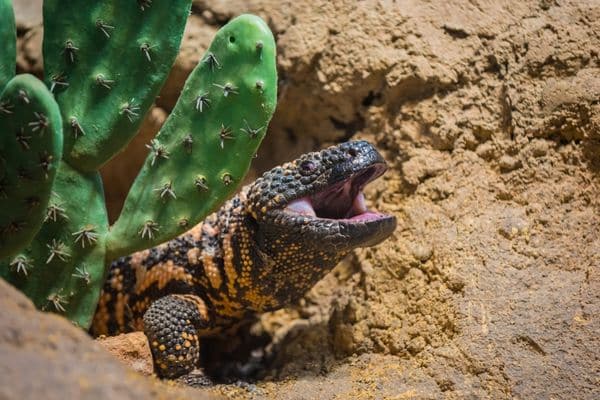
It spends most of its time underground, escaping the extreme heat, and is active primarily during cooler periods. While it possesses venom, incidents with humans are rare.
Encounters in the Valley are infrequent due to the creature’s reclusive nature. Respect its space, and it’s unlikely to pose any threat. Awareness and understanding of the Gila Monster’s habits will ensure safe interactions during your visit.
Rattlesnakes
The echoing rattle of a snake is an unmistakable sound that can send chills down the spine of even the most seasoned hiker. In the Valley of Fire, several species of rattlesnakes have made the sun-baked rocks and sandy hideouts their home. Among them are the Western Diamondback, Mojave, and Sidewinder rattlesnakes.
The Western Diamondback is one of the most recognized species due to its distinctive diamond pattern and can grow up to seven feet in length. Its venom can be potent, and an untreated bite can be dangerous.
The Mojave Rattlesnake is especially noteworthy because of the potency of its venom, which contains powerful neurotoxins. Often mistaken for other rattlesnakes due to its similar appearance, the Mojave’s venom is considered more toxic than most of its counterparts.
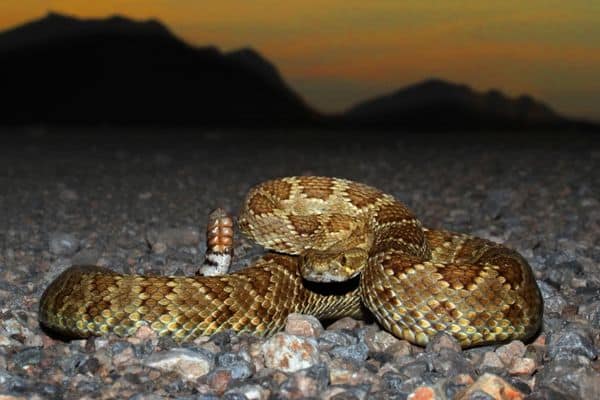
Lastly, the Sidewinder, named for its unique sideways movement, is smaller and is easily identified by the horn-like structures over its eyes. While its venom is not as potent as the Mojave’s, a bite from a Sidewinder can still be painful and requires medical attention.
The danger these snakes pose is primarily defensive. Rattlesnakes don’t actively seek out encounters with humans. Most bites occur when a snake is surprised or feels threatened.
By staying on marked paths, being vigilant in rocky and sandy areas, and giving any snake you encounter a wide berth, the risk of an unfortunate encounter diminishes greatly.
Remember, these creatures are a vital part of the Valley of Fire’s ecosystem, playing essential roles in controlling pest populations and serving as prey for larger predators. They deserve our respect and caution, not our fear.
Desert Tarantulas
In the Valley of Fire, among the vast stretches of red sandstone and rugged terrain, resides the often misunderstood Desert Tarantula. These arachnids, with their large, hairy bodies, are undoubtedly attention-grabbing, but they are more fascinating than fearsome.
Desert Tarantulas can span up to 4 inches in leg length. They are typically brown or gray, allowing them to blend seamlessly with their sandy surroundings. Most active during the cooler months, especially after the sun sets, these nocturnal creatures venture out in search of prey, which includes insects, beetles, and other small arthropods.
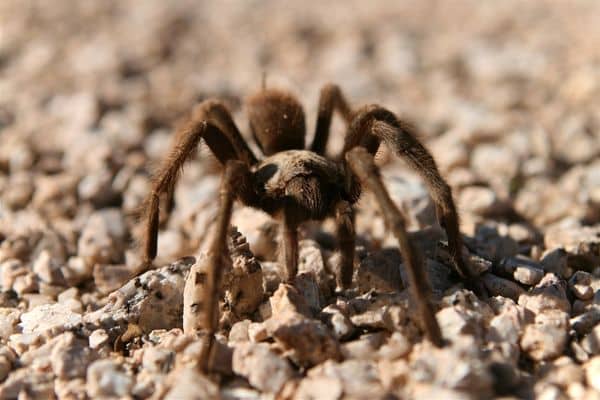
Contrary to popular belief, tarantulas are not aggressive towards humans. Their primary defense mechanisms are their urticating hairs, which they can release if threatened.
These hairs can cause irritation if they come into contact with human skin or eyes. While they do possess venom, a bite from a Desert Tarantula is often compared to a bee sting in terms of pain and is not considered medically significant.
The presence of tarantulas in the Valley of Fire is a testament to the region’s rich biodiversity. Visitors should consider themselves lucky to spot one in the wild. As with all creatures in this protected area, it’s important to observe from a distance and never handle or disturb them. By doing so, visitors can appreciate these magnificent spiders in their natural habitat and ensure a harmonious coexistence.
Bark Scorpion
The Valley of Fire, with its vast expanse of desert landscapes, hosts a variety of creatures, including the elusive Bark Scorpion. Often considered one of the most venomous scorpions in North America, the Bark Scorpion is both a marvel of desert adaptation and a creature to approach with caution.
Sporting a slender tail and a pale-yellow to orange hue, the Bark Scorpion typically measures about 2 to 3 inches in length. These nocturnal arthropods are climbers, frequently found on vertical surfaces and under tree barks, from which their name is derived. They hunt during the cooler nights, preying on insects, spiders, and sometimes even other scorpions.
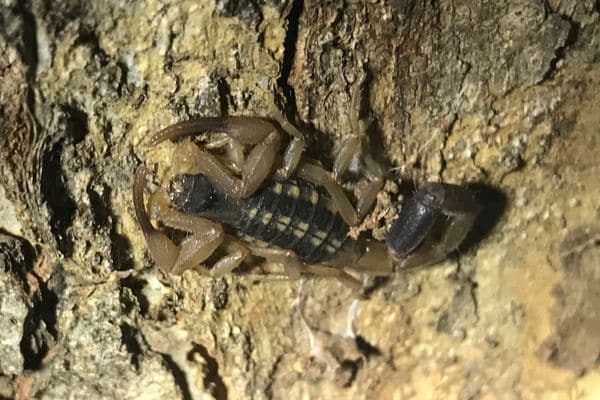
While they are naturally reclusive, their venom demands respect. A sting from a Bark Scorpion can be intensely painful and may result in localized swelling, numbness, and tingling sensations. In some rare cases, especially with sensitive individuals, more severe symptoms might occur, warranting immediate medical attention.
For visitors to the Valley of Fire, the key to a safe experience lies in awareness. Check shoes, clothing, and bedding before use, especially if left outdoors or on the ground overnight. At night, use a UV flashlight, as scorpions fluoresce under ultraviolet light, making them easier to spot.
Despite their fearsome reputation, Bark Scorpions play a vital role in the desert ecosystem, controlling pest populations and serving as prey for larger animals. Like all residents of the Valley of Fire, they warrant respect and understanding, reinforcing the need for a balanced coexistence with the wild.
Desert Centipedes
Navigating the sun-soaked terrains of the Valley of Fire, the Desert Centipede is a fascinating, yet often overlooked inhabitant. Characterized by its elongated body, multitude of legs, and vibrant colors, this creature is an epitome of desert adaptation and survival.
Typically ranging from 4 to 8 inches in length, the most common desert centipede in the region is the Giant Desert Centipede, distinguishable by its reddish-brown body with yellowish-tinted legs.
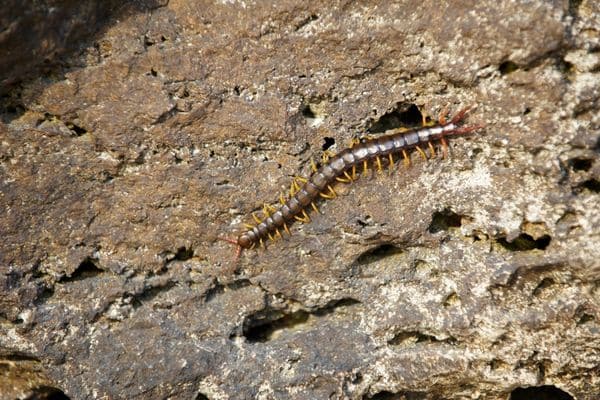
These nocturnal arthropods are adept predators, hunting insects, spiders, and even small vertebrates, using their modified front legs, or “forcipules”, to inject venom into their prey.
It’s this venom that demands caution. While Desert Centipedes generally avoid humans, they can deliver a painful bite if threatened or handled. The pain has been likened to a bee sting, though reactions can vary based on the individual and the amount of venom injected.
While not typically life-threatening, symptoms can include localized pain, swelling, and redness. In some cases, more severe reactions can occur, emphasizing the importance of seeking medical attention if bitten.
For those trekking through the Valley of Fire, awareness is key. Avoid placing hands or feet where you can’t see, and always be cautious when moving rocks or debris.
Despite the potential discomfort they can cause, it’s crucial to remember that Desert Centipedes play a significant role in the local ecosystem, controlling pest populations and maintaining the balance of the desert food web. They are yet another testament to the diverse and resilient life that calls the Valley of Fire home.
Black Widow Spiders
One of the most iconic and often misinterpreted inhabitants of the Valley of Fire is the Black Widow Spider. With a reputation that precedes them, largely due to the hourglass-shaped red mark on the abdomen of the females, these spiders are both revered and approached with caution in desert environments.
Black Widows are medium-sized spiders, with females being the most recognizable due to their shiny black bodies and aforementioned red marking.
They prefer secluded, undisturbed spots, often spinning their irregular, tangled webs in sheltered locations such as under rocks, in crevices, or amid debris.
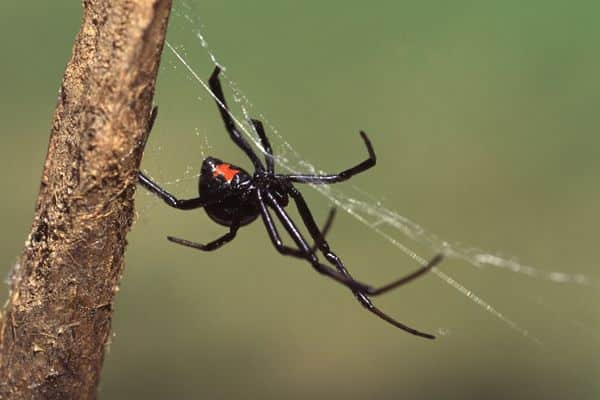
While these spiders are indeed venomous, they are not inherently aggressive towards humans. Bites are rare and usually occur when the spider feels threatened, especially if it’s unintentionally pressed against human skin, like when reaching into a hidden spot without looking.
The venom of the Black Widow is neurotoxic, which means it affects the nervous system. Symptoms can include muscle pain, cramps, and in some cases, more severe systemic reactions. Immediate medical attention is advised in the event of a bite.
For visitors to the Valley of Fire, it’s beneficial to be mindful of their surroundings. Before reaching into hidden or dark places, take a moment to inspect for the presence of webs or the spiders themselves. Shake out shoes, clothing, and bedding if left outside overnight.
They help control populations of harmful pests, contributing to the ecological balance of the Valley of Fire. As with all creatures in this unique environment, understanding, respect, and a bit of caution ensure harmonious coexistence.
Coyotes
The howl of the coyote, echoing through the vast landscapes of the Valley of Fire, is emblematic of the wild spirit of the American Southwest. These adaptable and intelligent canids have not only survived but thrived in the challenging desert environment, making them one of the most iconic creatures of the region.
Coyotes are medium-sized animals, with a slender physique and a coat that varies from gray to sandy brown, allowing them to blend seamlessly into the desert backdrop. They possess keen senses, especially their hearing and sight, which aid them in hunting a diverse diet ranging from small mammals and birds to fruits and insects.
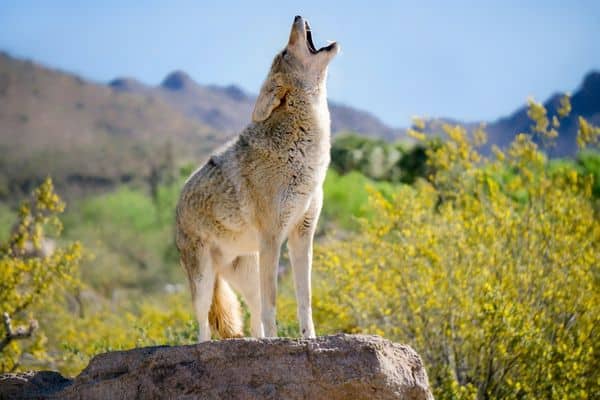
Despite their wild nature, coyotes have shown remarkable adaptability, sometimes coming into close proximity with human settlements. However, in places like the Valley of Fire, they remain predominantly elusive and wary of human presence.
While they don’t typically pose a direct threat, it’s essential to be aware of their opportunistic nature. They can be attracted to unsecured food, litter, or even small pets left unattended.
Visitors to the Valley of Fire should adhere to a few basic guidelines to ensure harmonious interactions with coyotes. Keeping a safe distance, securing food and trash, and not feeding them are paramount. Feeding not only endangers the individual but can lead to problematic behavior from the coyotes in the future.
Understanding the role of coyotes in the ecosystem is crucial. They help control rodent populations and, as apex predators, maintain the health and balance of the desert food chain. As we tread the paths of the Valley of Fire, respecting the habitat and behaviors of the coyote reminds us of the delicate balance and beauty of life in the desert.
Mountain Lions
Mountain lions, also known as cougars, pumas, or panthers, are the embodiment of stealth and strength in the Valley of Fire. As one of the apex predators of the region, their presence, though rarely seen, has a profound influence on the desert ecosystem.
Physically impressive, mountain lions have a sleek, muscular body covered in a tawny coat, which aids in camouflage against the desert backdrop. Adult males can weigh up to 200 pounds, while females are slightly smaller.
Their large paws and powerful hind legs make them skilled climbers and jumpers, able to ambush prey with a mix of speed and precision.
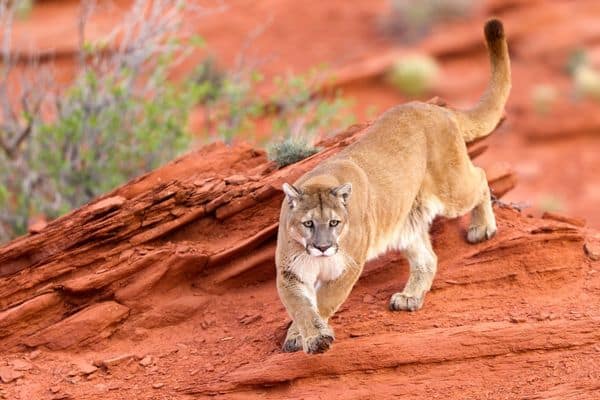
In the vast expanses of the Valley of Fire, mountain lions maintain territories that can span over a hundred square miles, depending on the availability of prey. Their diet primarily consists of deer, but they won’t hesitate to consume smaller mammals or even larger animals when the opportunity arises.
While encounters with humans are extremely rare, the inherent wild nature of mountain lions necessitates caution. If you’re in their territory, it’s essential to be aware of your surroundings, especially during dawn and dusk when these cats are most active.
In the unlikely event of an encounter, it’s advised to maintain eye contact, appear as large as possible, and slowly back away without turning your back on the animal. Running might trigger their chase instinct.
Visiting the Valley of Fire provides a unique opportunity to tread the same ground as this majestic predator. Their role in the ecosystem is paramount, regulating prey populations and ensuring the health of the environment.
The mountain lion’s presence is a reminder of the wild heart of the desert, and like all inhabitants of the Valley, they deserve our utmost respect and understanding.
Desert Bighorn Sheep
The rugged landscapes of the Valley of Fire, with its towering cliffs and undulating terrains, serve as a backdrop for one of North America’s most iconic wild residents: the Desert Bighorn Sheep. Recognizable by their spiraled horns and muscular build, these animals are a testament to nature’s ability to adapt and thrive in seemingly inhospitable environments.
Desert Bighorn Sheep are well-adapted to the arid conditions of the Valley. Their light brown to beige coats blend seamlessly with the rocky terrain, providing them with a degree of camouflage.
Males, or rams, are particularly notable for their massive curled horns, which can weigh up to 30 pounds. Females, or ewes, possess smaller, spike-like horns.
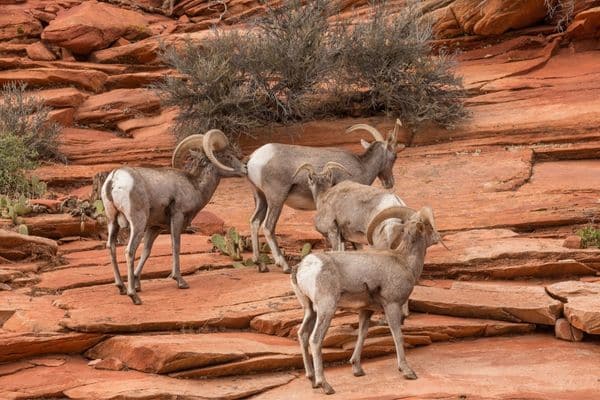
One of the remarkable adaptations of the Desert Bighorn Sheep is their ability to survive with minimal water. They can extract moisture from food and conserve water through their physiological processes, allowing them to endure the scorching heat of the desert.
Their split hooves provide excellent traction, enabling them to navigate the steep and rocky terrains with agility.
In the Valley of Fire, these sheep are often seen grazing on sparse vegetation or scaling near-vertical cliffs with ease. While they generally keep their distance from human visitors, it’s crucial to avoid approaching or feeding them.
Not only can human food be harmful to their health, but close encounters can also lead to habituation, making them more vulnerable to threats.
The presence of Desert Bighorn Sheep in the Valley of Fire is a reminder of the intricate balance of life in the desert. As a keystone species, their grazing habits play a significant role in shaping the vegetation patterns of the region.
For those fortunate enough to witness these majestic animals in their natural habitat, it’s an experience that underscores the richness and resilience of the desert ecosystem.
Ravens
Over the rich tapestry of reds, oranges, and yellows that define the Valley of Fire’s landscapes, a familiar silhouette often casts its shadow— the raven. With their glossy black feathers and distinctive croaking calls, ravens are an integral part of the desert environment, showcasing intelligence and adaptability that few other birds possess.
Ravens are among the largest of the passerine birds, easily recognized by their all-black appearance, wedge-shaped tail, and robust beak.
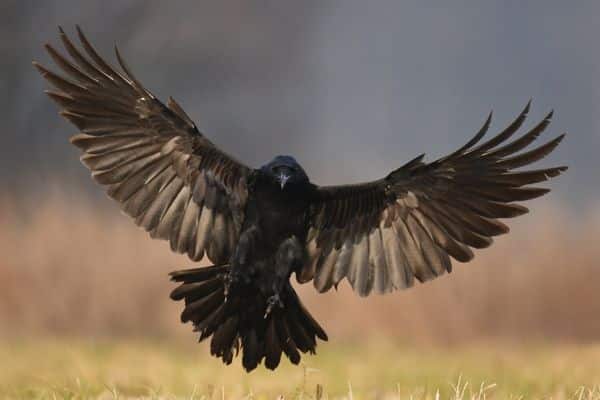
Their keen eyes are not only for spotting food; they’re also windows to one of the most advanced avian brains. Studies have shown that ravens are capable of problem-solving, planning, and even exhibiting behaviors that hint at a rudimentary sense of play.
In the Valley of Fire, ravens are opportunistic feeders, consuming a varied diet that ranges from insects and small mammals to fruits and seeds.
They’re also known scavengers, often seen foraging near campsites or roadways. Their presence in these areas is a testament to their adaptability and ability to exploit a wide range of food sources.
While their intelligence and curiosity often make them entertaining to observe, it’s essential for visitors to the Valley of Fire to avoid feeding them. Human food is not suitable for their health, and regular feeding can lead to dependency and alter their natural behaviors.
Ravens play a multifaceted role in the desert ecosystem. They help control pest populations, serve as scavengers cleaning up carrion, and even act as seed dispersers, aiding in the propagation of various plant species.
Their presence in the Valley of Fire reminds us of the intricate web of life that exists even in such a seemingly barren landscape. As guardians of the desert skies, ravens deserve our admiration and respect.
Tips to Stay Safe While Hiking and Camping in the Valley of Fire
- Proper Clothing and Gear: Wear long pants, sturdy hiking boots, and gloves if handling rocks or brush. This provides an added layer of protection against potential bites, stings, or scratches from animals and insects.
- Stay on Designated Trails: Venturing off the path can not only harm the environment but also increase the risk of encountering wildlife in less predictable areas.
- Time Your Adventures Right: Wildlife, especially predators, are often most active during dusk and dawn. If possible, plan hikes and activities outside these times.
- Safe Food Storage: Always store food in sealed containers and, if possible, elevated or in designated storage areas. This helps prevent attracting curious animals to your campsite.
- First-Aid Knowledge: Familiarize yourself with basic treatments for common bites and stings. Carry a first-aid kit equipped with essentials like antihistamines, pain relievers, and antiseptic wipes.
- Respect Wildlife Boundaries: Always keep a safe distance from any wildlife you encounter. Use binoculars or cameras with zoom lenses to get a closer look without approaching.
- Never Feed the Animals: Human food can be harmful to wildlife and feeding them can alter their natural behaviors, making them more susceptible to threats.
- Stay Hydrated and Informed: The desert environment can be harsh. Carry sufficient water, and be aware of weather forecasts, especially during hotter months.
- Travel in Groups: There’s safety in numbers. Hiking or camping with a group not only enhances the experience but also deters potential wildlife threats.
- Educate Yourself: Before your trip, learn about the local fauna and their habits. Familiarity can help you predict and understand their behaviors, leading to safer encounters.
Arming yourself with these tips and a healthy respect for the Valley of Fire’s inhabitants will ensure your adventures are memorable for all the right reasons.
Key Takeaways: Navigating Wildlife in the Valley of Fire
- Nature’s Balance: The Valley of Fire’s beauty isn’t just in its landscapes but also its rich tapestry of wildlife. From the stealthy mountain lion to the intelligent raven, each creature plays an intrinsic role in the ecosystem.
- Approach with Respect: While some animals can pose potential risks, they are generally more scared of you than you are of them. Treat them with respect, maintain distance, and avoid provoking them.
- Stay Informed: Knowledge about local wildlife – their habits, active times, and typical habitats – can help in anticipating and avoiding dangerous encounters.
- Safety First: Proper attire, staying on designated trails, and ensuring safe food storage can significantly reduce potential risks.
- First Aid Ready: Accidents are rare, but being prepared with a basic first-aid kit and knowledge can be a lifesaver.
- Don’t Feed the Wildlife: Offering food not only endangers them but can also lead to unwanted attention and alter their natural behavior.
- Know the Terrain: The Valley of Fire’s environment can be as challenging as its fauna. Ensure you’re prepared for its climate and stay hydrated.
- Group Expeditions: Exploring in groups not only enhances the experience but can also be a deterrent for potential wildlife threats.
- Admire from a Distance: Use binoculars or zoom lenses to observe wildlife, ensuring you don’t invade their personal space.
- Preserve Their Home: Leave no trace, stick to designated areas, and ensure you’re not inadvertently harming the environment or its inhabitants.
Remember, the Valley of Fire is a region where the beauty of the natural world converges with the wild. With preparation and respect, every visitor can have an enriching and safe experience.

